Virtual reality has fundamentally transformed the world of sim racing, offering a level of immersion that traditional monitors cannot replicate. By placing you directly inside the cockpit, a VR headset allows for natural head movement to check mirrors, look into an apex, and accurately judge distances, creating an unparalleled sense of presence and speed. For enthusiasts looking to elevate their experience on popular titles like iRacing, Assetto Corsa Competizione, or F1 23, selecting the right VR headset is a critical decision.
This purely informational guide provides a detailed analysis of popular and historically significant VR headsets. We will examine their current status, dissect their technical specifications, and offer an objective look at their suitability for the demanding environment of sim racing.
Understanding the Core Technology for Sim Racing VR
Before diving into specific products, it’s essential to understand the different tiers of VR technology.
- PC VR Headsets: These are the gold standard for high-fidelity sim racing. They connect directly to a powerful gaming PC, leveraging its dedicated graphics card (GPU) and processor (CPU) to render complex, high-resolution virtual environments with minimal latency. This is the category most relevant to serious sim racers. A powerful PC is a prerequisite, and you’ll want to ensure your PC has the best airflow and a capable motherboard to handle the load.
- Standalone VR Headsets: These devices, like the Meta Quest series, contain their own processors and don’t require a PC to operate. However, for sim racing, their primary value comes from their ability to connect to a PC via a USB-C cable (a feature known as Meta Link) or wirelessly over Wi-Fi, effectively acting as a PC VR headset. This hybrid functionality offers tremendous flexibility.
- Smartphone VR Headsets: This category consists of simple plastic or cardboard enclosures that use a smartphone as the screen and processor. Due to significant limitations in tracking, performance, latency, and display quality, they are not a viable option for the fast-paced, precision-demanding world of sim racing.
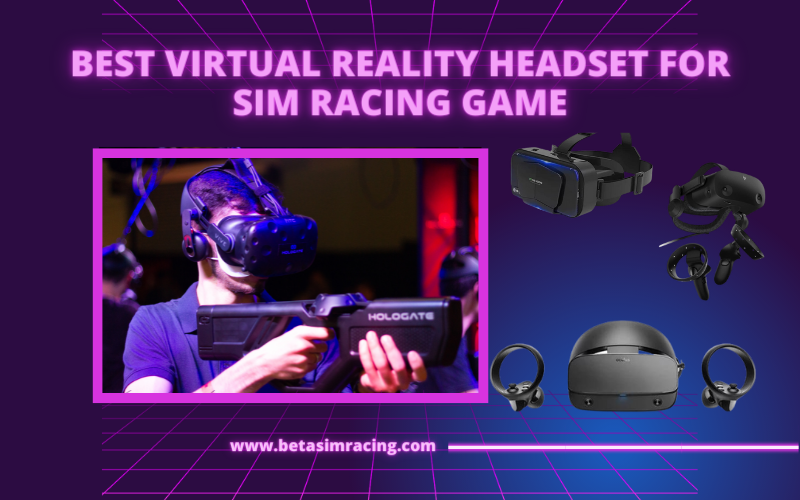
2025 Sim Racing VR Headset Specifications Compared
This table provides a high-level overview of the headsets discussed in this article, updated with their status and key specifications relevant to sim racing.
| Feature | Oculus Rift S | FEEBZ VR Headset | HP Reverb G2 | VR SHINECON | Pimax Vision 5K Super |
| Status | Discontinued | Active | Discontinued | Active | Succeeded by new models |
| Type | PCVR | Smartphone Holder | PCVR | Smartphone Holder | PCVR |
| Display | Single Fast-Switch LCD | Varies by Phone | Dual LCD | Varies by Phone | Dual CLPL |
| Resolution | 1280 x 1440 per eye | Varies by Phone | 2160 x 2160 per eye | Varies by Phone | 2560 x 1440 per eye |
| Refresh Rate | 80 Hz | Varies by Phone | 90 Hz | Varies by Phone | Up to 180 Hz |
| Field of View (H) | ~90° | Varies by Phone | ~98° | Varies by Phone | ~170° (200° diagonal) |
| Tracking | Inside-Out (5 cameras) | 3-DoF (Phone IMU) | Inside-Out (4 cameras) | 3-DoF (Phone IMU) | Outside-In (SteamVR) |
| IPD Adjustment | Software only (61.5-65.5mm) | None | Manual (60-68mm) | Manual (Lens position) | Manual (58-70mm) |
| Audio | Integrated open-ear | Via Phone | Integrated near-field | Via Phone | Integrated modular audio |
| Connection | DisplayPort 1.2, USB 3.0 | N/A | DisplayPort 1.3, USB-C | N/A | DisplayPort 1.4, USB 3.0 |
| Sim Racing Focus | Entry-Level (Outdated) | Not Suitable | Mid-Range Clarity (Outdated) | Not Suitable | Enthusiast FOV (Outdated) |
In-Depth Analysis of Sim Racing VR Headsets
Here we detail each of the original five headsets, providing their specifications, current relevance, and suggestions for modern alternatives where applicable.
1. Oculus Rift S
The Oculus Rift S was a significant PC VR headset that offered a streamlined setup compared to its predecessor, the original Rift CV1. It was a popular entry point for many into PC-based virtual reality.
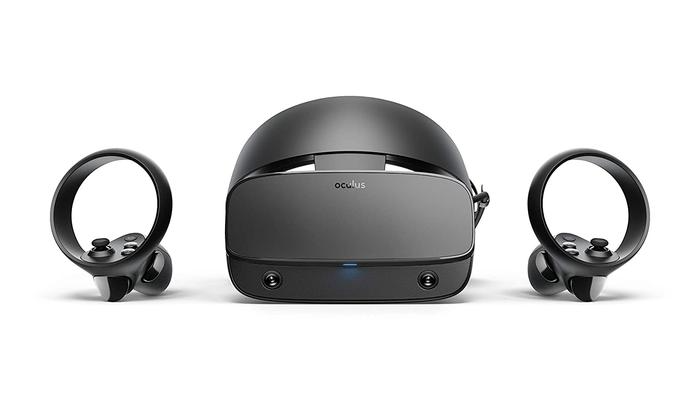
Oculus Rift S: Original Specifications
- Display: Single fast-switch LCD panel
- Resolution: 1280 x 1440 pixels per eye
- Refresh Rate: 80 Hz
- Field of View: Approximately 90 degrees horizontal
- Tracking: “Insight” inside-out tracking with 5 embedded cameras
- Connection: A single cable with DisplayPort 1.2 and USB 3.0 connectors
Current Status in 2025: Discontinued
The Oculus Rift S was officially discontinued by Meta (formerly Facebook) in April 2021. It is no longer manufactured or sold new. While units can be found on the second-hand market, it is considered legacy hardware. Its software-only IPD adjustment and lower resolution are significantly behind current standards.
Modern Alternative: Meta Quest 3
For users considering a Rift S, the Meta Quest 3 is its spiritual and technological successor and a superior choice in every category. It functions as a standalone headset but truly shines for sim racers when connected to a PC.
- Superior Resolution: 2064 x 2208 pixels per eye provides a massive clarity boost for reading gauges and spotting braking points.
- Higher Refresh Rate: Supports up to a 120 Hz refresh rate for a smoother experience.
- Pancake Lenses: Offers edge-to-edge clarity, a significant improvement over the Fresnel lenses of the Rift S which had a small “sweet spot.”
- Flexible Connectivity: Can be connected to a PC via a USB-C cable or wirelessly with Wi-Fi 6E for a tether-free experience.
2. FEEBZ VR Headset
The FEEBZ VR headset is representative of a broad category of budget-friendly devices designed to turn a smartphone into a VR viewer.
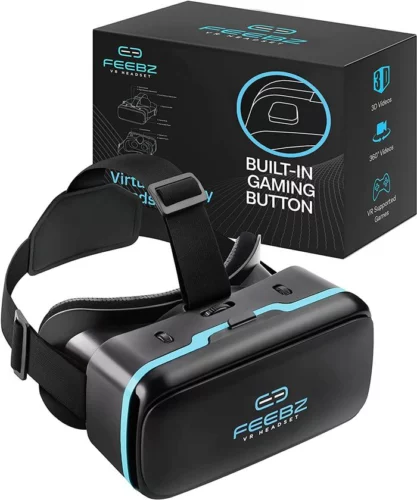
FEEBZ VR Headset: General Specifications
- Type: Smartphone holder/enclosure
- Compatibility: Fits a range of iPhone and Android smartphones.
- Features: Typically includes adjustable straps, basic lens position adjustment, and sometimes a single capacitive input button. All processing, display, and tracking are handled by the phone itself.
Current Status in 2025: Active (as a Smartphone Holder)
Devices like the FEEBZ headset are still widely available and marketed as an accessible entry point to VR, often for children or for watching 360-degree videos.
Suitability for Sim Racing
Blockquote: Smartphone-based VR headsets are not suitable for sim racing. They lack the positional (6DoF) tracking necessary to lean into corners or move your head around the cockpit. They are limited to rotational (3DoF) tracking, which only follows where you are looking. Furthermore, phone performance, latency, and display refresh rates are not optimized for the high-speed, low-latency demands of simulation, which would lead to a disorienting and unplayable experience.
3. HP Reverb G2
Upon its release, the HP Reverb G2 was highly regarded in the sim racing community, primarily for its class-leading visual clarity at a competitive price point.
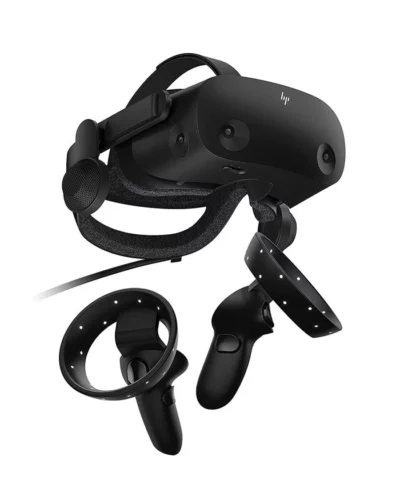
HP Reverb G2: Original Specifications
- Display: Dual 2.89-inch LCD panels
- Resolution: 2160 x 2160 pixels per eye
- Refresh Rate: 90 Hz
- Field of View: Approximately 98 degrees horizontal
- Tracking: Inside-out tracking via 4 embedded cameras
- Connection: DisplayPort 1.3 and USB-C
Current Status in 2025: Discontinued but Functional
HP has discontinued the Reverb G2, and there is no direct successor (G3) on the market. Furthermore, Microsoft has deprecated its Windows Mixed Reality (WMR) platform, which the G2 relies on. While existing devices will continue to function with SteamVR until at least November 2026, the platform is no longer receiving feature updates.
Considerations for 2025
While its resolution remains impressive, the ecosystem is a dead end. The tracking volume for its controllers was also noted to be smaller than competitors. For sim racing (a seated, forward-facing experience), the controller tracking is less of an issue. However, given its discontinued status and the end-of-life WMR platform, purchasing a Reverb G2 is only advisable if found at a very steep discount and with a full understanding of its limited future. Many users have since moved to alternatives like the Meta Quest 3 or high-end Pimax models.
4. VR SHINECON Headset
Similar to the FEEBZ headset, VR SHINECON is a popular brand in the smartphone VR holder market. It offers a plastic enclosure to house a smartphone for basic VR experiences.
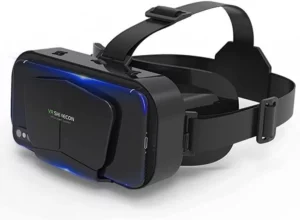
VR SHINECON: General Specifications
- Type: Smartphone holder/enclosure
- Compatibility: Designed for a wide array of smartphones, typically up to 7 inches.
- Features: Adjustable head strap, manual focus and lens-width adjustments, and sometimes bundled with a small Bluetooth remote for basic interaction.
Current Status in 2025: Active (as a Smartphone Holder)
VR SHINECON headsets continue to be sold globally as a low-cost method for viewing VR videos or playing simple 3DoF mobile games.
Suitability for Sim Racing
For the same reasons as the FEEBZ headset, the VR SHINECON is inappropriate for serious sim racing. The limitations of 3DoF tracking, inconsistent performance, and high potential for motion sickness make it a non-starter. A true PC VR or PC-connected standalone headset is required for a proper sim racing setup.
5. Pimax Vision 5K Super
Pimax carved out a niche in the VR market by focusing on one key specification: an ultra-wide Field of View (FOV). The Vision 5K Super was an evolution of their initial models, aimed at enthusiast users.
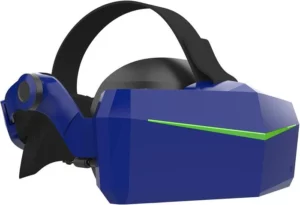
Pimax Vision 5K Super: Original Specifications
- Display: Dual Custom Low Persistence Liquid (CLPL) panels
- Resolution: 2560 x 1440 pixels per eye
- Refresh Rate: Supports multiple modes, up to an experimental 180 Hz
- Field of View: Up to 200 degrees diagonal (approximately 170 degrees horizontal)
- Tracking: Requires external SteamVR 1.0 or 2.0 base stations for tracking (sold separately).
Current Status in 2025: Succeeded by Newer Models
While the Pimax 5K Super remains a capable headset, it has been largely superseded by Pimax’s newer offerings. The company’s focus has shifted to its “Crystal” line, which aims to combine a wide FOV with much higher pixel density (clarity).
Modern Alternative: Pimax Crystal Light / Crystal Super
The Pimax Crystal Light and Crystal Super are the modern evolution of the Pimax philosophy. They offer a significant upgrade over the 5K Super.
- Exceptional Clarity: The Crystal models boast a resolution of 2880 x 2880 (Light) or 3840 x 3840 (Super) per eye, resulting in industry-leading PPD (Pixels Per Degree). This makes distant objects on track incredibly sharp.
- High-Quality Lenses: Utilizes glass aspherical lenses for improved clarity across the visual field.
- Flexible Tracking: Features inside-out tracking as standard, with an optional faceplate to add compatibility with SteamVR base station tracking for users who demand it.
- Target Audience: These are high-end, enthusiast-grade products that require a top-tier graphics card like an RTX 4090 to be used to their full potential.
Key Factors for Choosing a VR Headset for Sim Racing
When evaluating a VR headset specifically for sim racing, certain technical aspects are more important than others.
Resolution and Pixels Per Degree (PPD)
High resolution is paramount. Sharper images allow you to see distant corners, spot braking markers earlier, and read your car’s dashboard instruments clearly. It directly combats the “screen door effect” (seeing the gaps between pixels). PPD is an even better metric, as it combines resolution and FOV to describe the visual density. For sim racing, a higher PPD is always better.
Field of View (FOV)
A wide FOV enhances peripheral vision, which is crucial for immersion and situational awareness. It allows you to see cars alongside you more naturally without having to turn your head as much. While standard headsets offer around 90-100 degrees horizontally, enthusiast brands like Pimax push this to 140 degrees or more, closely mimicking natural human vision.
Refresh Rate
Refresh rate, measured in Hertz (Hz), is the number of times the display updates per second. A higher refresh rate (90 Hz, 120 Hz, or more) results in a smoother, more fluid image. For a fast-paced activity like racing, a high refresh rate can reduce motion sickness and create a greater sense of realism.
Tracking System: Inside-Out vs. Base Stations
- Inside-Out: Cameras on the headset track its position by observing the environment. This is simpler to set up and is more than sufficient for seated sim racing.
- Base Stations (Outside-In): External sensors (“lighthouses”) are placed in the corners of your room. This system provides the most robust and precise tracking over a large area but is more complex and expensive. For a dedicated sim racing cockpit, inside-out tracking is perfectly adequate.
PC System Requirements
Driving high-resolution displays at a high refresh rate is incredibly demanding. Before investing in a high-end VR headset, ensure your PC meets or exceeds the recommended specifications. This primarily involves having a powerful, modern graphics card (GPU) and a capable CPU. Check the specific requirements for the headset you are considering. For example, the system requirements for iRacing in VR are significantly higher than for playing on a monitor.
Wired vs. Wireless Connectivity
For sim racing, a wired connection via DisplayPort or USB-C is generally preferred. This method ensures the highest possible image quality and zero latency, which are critical for competitive driving. While wireless PC VR is possible with some headsets and offers more freedom, it relies on a very strong Wi-Fi network and introduces compression and a small amount of latency that may be perceptible to highly sensitive users.
Frequently Asked Questions (FAQ)
Is VR better than triple monitors for sim racing?
This is a matter of preference. VR offers superior depth perception and immersion, making you feel like you are truly in the car. Triple monitors offer a wider, uncompromising field of view without the need to wear a headset, which some find more comfortable for long endurance races and easier for interacting with external button boxes or keyboards.
Can you get motion sickness while sim racing in VR?
Yes, it is possible, especially for new users. Motion sickness in VR often occurs when there is a mismatch between what your eyes see (high-speed movement) and what your inner ear feels (sitting stationary). This can be mitigated by ensuring your PC can maintain a high, stable frame rate and by gradually increasing the length of your VR sessions.
Do I need a specific racing wheel for VR?
No, any modern PC-compatible racing wheel, from a Logitech G923 to a high-end Fanatec direct drive wheel, will work with VR. The virtual reality experience is visual; your physical controls operate independently.
What is the most important component in a PC for VR sim racing?
The graphics card (GPU) is the single most important component. It is responsible for rendering the two separate, high-resolution images (one for each eye) at a consistently high frame rate. A powerful GPU is essential to avoid stuttering and ensure a smooth experience.
Can I wear glasses inside a VR headset?
Most modern VR headsets are designed with enough space to accommodate glasses. However, it can sometimes be uncomfortable, and there is a risk of scratching both your glasses and the headset lenses. Many users with corrective vision opt for custom prescription lens inserts that can be fitted directly into the headset.

With a background in mechanical engineering and over a decade in competitive sim racing, Kenji serves as our lead Sim Racing Physics & Hardware Analyst. He deconstructs complex topics like force feedback and suspension geometry, helping readers understand the crucial engineering behind a perfect lap time. Kenji’s passion is to translate real-world motorsport principles into actionable knowledge for the sim racing community.
